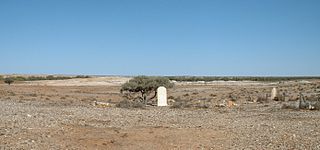Albert Goldfield facts for kids
The Albert Goldfield is an area of 1300 square kilometres (500 square miles) where gold was discovered in the outback of New South Wales in 1880. Gold was found at Mount Browne, which is 53 km (33 mi) south west of Tibooburra. There were other finds at Good Friday, Easter Monday, Nuggerty, Pioneer Reef and Warratta Creek.
This is a very hot and dry area of Australia. Because of the shortage of water, towns were started at Milparinka and Tibooburra where there was water available. Towns at Albert and Mount Browne did not last for long because of the lack of water. By 1881 there were more than 2000 people living on the gold diggings or in the towns. Geologist William Henry John Slee was appointed resident Goldfield Warden. The miners had to either take their dirt to one of the towns to use water to pan for the gold, or use a method called dry blowing. Dry blowing means breaking the dirt into fine particles and letting the wind blow away the dirt leaving the heavier gold behind. Life on the goldfields was hard, water was scarce, fresh fruit and vegetables were not available, and basics like flour were very expensive. Disease, including dysentery and typhoid were common.
By 1893 the gold rush had ended and most people had left the goldfields.


